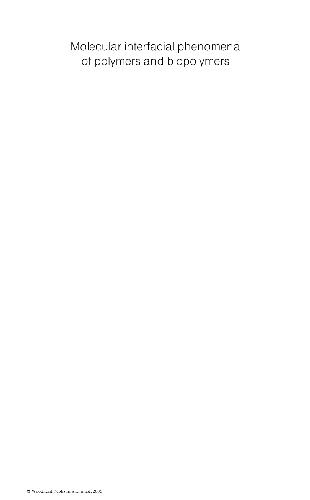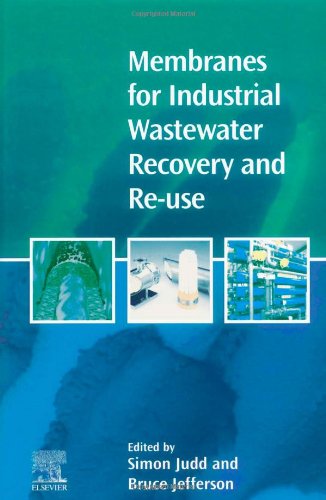P. Chen9780849334450, 0-8493-3445-4, 1-85573-737-X, 1-85573-838-4, 1-85573-930-5
Table of contents :
Molecular interfacial phenomena of polymers and biopolymers……Page 3
Contents……Page 5
Contributor contact details……Page 11
Preface……Page 15
Table of Contents……Page 0
Part I: Fundamentals……Page 18
1.1 Introduction……Page 19
1.2 Adsorption of proteins at liquid interfaces……Page 20
1.2.1 Thermodynamic models……Page 21
1.2.2 Adsorption kinetics model……Page 25
Surface tension and adsorption isotherms……Page 26
Dynamic surface tension and adsorption……Page 30
Direct measurements of protein adsorption……Page 35
1.3.1 Thermodynamic model for mixtures with non-ionic surfactant……Page 37
1.3.2 Mixtures of protein with ionic surfactant……Page 39
Surface tension and adsorption isotherms……Page 40
Dynamic surface tension……Page 46
Ellipsometric measurements of adsorption from mixed solutions……Page 48
1.4 Dilational elasticity and viscosity of interfacial layers……Page 51
1.4.1 Theoretical background……Page 52
1.4.2 Experimental examples……Page 53
1.4.3 Dilational elasticity and viscosity of mixed interfacial layers……Page 55
1.5 Summary and outlook……Page 58
1.7 References……Page 59
2.1 Introduction……Page 64
2.2 Monte Carlo (MC) simulation……Page 66
2.3 Molecular dynamics (MD) simulation……Page 69
2.4 Force fields……Page 71
2.5 Additional techniques……Page 73
2.6.1 MC simulation results……Page 75
2.6.2 MD simulation results……Page 77
2.6.3 Interfacial thickness and the Flory-Huggins interaction parameter……Page 81
2.7 Conclusion……Page 83
2.9 References……Page 84
3.1 Introduction……Page 88
3.2.1 Effect of temperature on permeation……Page 89
3.2.2 Effect of permeant and polymer structure on permeation……Page 91
3.2.3 Permeation of mixtures……Page 94
3.2.4 Effect of mechanical deformation on permeation……Page 95
3.3 Theory and modeling……Page 98
3.5 References……Page 107
4.1 Introduction……Page 114
4.2 The wormlike chain model: static chain properties……Page 116
4.3 Relaxation of a stiff chain……Page 118
4.4 Looping dynamics……Page 120
4.6 References……Page 130
4.7 Appendix: reaction-radius-dependence and compact vs. non-compact exploration……Page 132
5.1.1 Thermodynamics of contact angles – need for new theoretical models……Page 135
5.1.2 Energy barriers……Page 137
5.2 Theory……Page 139
5.2.1 Concept of liquid front……Page 140
5.2.2 Description of regular surface model and assumptions……Page 141
5.2.3 Changes in system free energy……Page 142
5.3.1 Roughness-dominated surfaces……Page 144
5.3.2 Heterogeneity-dominated surfaces……Page 147
5.3.3 Mixed-rough-heterogeneous surfaces……Page 149
5.4 Surface classification and surface feature factor……Page 151
5.5 Irregular surface model……Page 155
5.5.1 Roughness-dominated irregular surfaces……Page 156
5.5.2 Heterogeneity-dominated irregular surfaces……Page 157
5.5.3 Mixed-rough-heterogeneous irregular surfaces……Page 158
5.6.1 Definition of energy barriers……Page 159
5.6.2 Reproducibility of receding contact angles……Page 161
5.6.3 Contact angle hysteresis and vibrational energy……Page 164
5.6.4 ‘Stick-slip’ phenomena……Page 166
5.7 Conclusion……Page 168
5.9 References……Page 170
5.10 Appendix: Derivation of the surface feature factor……Page 172
Part II: Characterisation and manipulation……Page 175
6.1.1 Historical perspective……Page 176
6.2 SPM basics……Page 177
6.3.1 Contact……Page 179
6.3.2 Non-contact……Page 180
6.3.3 Intermittent contact……Page 181
6.4 Applications of scanning probe microscopy: imaging……Page 184
6.4.1 Studies of kinetic phenomena……Page 185
6.4.2 Crystallography……Page 186
6.4.3 Protein aggregation and fibril formation……Page 188
6.4.4 Membrane protein structure and assemblies……Page 189
6.5 Applications of scanning probe microscopy: force spectroscopy……Page 197
6.5.1 Single molecule force spectroscopy……Page 198
Pulsed force mode……Page 200
Binding forces……Page 201
Unfolding……Page 203
Mechanical properties……Page 205
6.6 Coupled imaging……Page 206
6.6.1 Near-field – SNOM/NSOM……Page 207
6.6.2 Evanscent-wave – TIRF……Page 208
6.7 Future trends……Page 210
6.8 References……Page 211
7.1 Introduction……Page 229
7.2.1 Quantum yield……Page 230
Protective quenching……Page 231
Static quenching……Page 232
7.2.3 Excimer formation……Page 233
7.2.4 Fluorescence resonance energy transfer……Page 235
7.2.5 The /1//3 ratio……Page 236
7.2.7 Fluorescence anisotropy……Page 237
7.3.1 Hydrophobically modified water-soluble polymers……Page 238
Water-soluble polymers hydrophobically modified with pyrene……Page 239
HMWSPs……Page 241
Interactions between surfactants and HMWSP……Page 243
7.3.2 Hydrophilically modified oil-soluble polymers……Page 244
7.3.3 Polymer chain dynamics in solution……Page 247
7.3.4 Polymers with branched architectures……Page 248
7.3.5 Polymer/particle interfaces……Page 251
7.3.6 Polymer films……Page 252
7.3.7 Polymeric gels……Page 255
7.4 Applications to biochemistry……Page 256
7.5 Conclusion……Page 258
7.6 References……Page 259
8.1.1 Introduction……Page 264
8.1.2 Dynamic surface tension measurement: drop shape methods……Page 265
8.1.3 Axisymmetric drop shape analysis – profile (ADSA-P)……Page 266
8.1.5 Image analysis in conjunction with ADSA……Page 267
8.2.1 Image acquisition system……Page 269
8.2.3 Environmental control system……Page 270
8.3.1 Sessile drop (SD)……Page 271
8.3.3 Captive bubble (CB)……Page 274
8.4 Study of pulmonary surfactants……Page 275
8.4.1 Film formation studies using PD……Page 276
VAST isotherms……Page 278
SA isotherms……Page 281
8.4.3 High surfactant concentration studies using CSD……Page 284
8.5 Study of protein-lipid interaction……Page 285
8.6 Study of protein adsorption at the solid surfaces……Page 289
8.8 References……Page 294
9.1 Introduction……Page 301
9.3.1 Langmuir film balance……Page 302
9.3.2 Infrared reflection absorption spectroscopy (IRRAS)……Page 303
9.3.3 Grazing incidence X-ray diffraction (GIXD)……Page 304
9.3.4 X-ray reflectivity measurements……Page 305
Third step……Page 307
9.4.1 Adsorption of polyelectrolytes to charged monolayers……Page 308
Adsorption of fully-charged polyelectrolytes……Page 309
Adsorption of charge-diluted polyelectrolytes……Page 314
9.4.2 DNA-alignment at cationic and zwitterionic lipid monolayers at the air/water-interface……Page 317
DNA adsorption to cationic monolayers……Page 318
DNA adsorption to zwitterionic monolayers……Page 323
9.4.3 Stepwise multilayer formation of cyclolinear polyorganosiloxanes floating at the air-water interface……Page 327
Pressure-area isotherms and XR experiments with CL-POSi……Page 328
GIXD experiments with cyclolinear polyorganosiloxanes……Page 330
9.6 References……Page 333
10.1 Introduction……Page 338
10.2 Surface tension – estimation and prediction from theoretical approaches……Page 341
10.3.1 Contact angle concept, Young equation……Page 345
10.3.2 Capillary penetration of liquids into porous polymer systems……Page 352
10.4.1 Contact angles on imperfect solid surfaces……Page 354
10.5 New strategies to determine experimentally the surface tension of polymer melts at elevated temperatures……Page 362
10.6.1 Effect of side chains and backbones of linear polymers……Page 364
Additives of linear backbones: polyacrylates, polysiloxanes……Page 373
Hyperbranched polyesters as surface tension modifiers……Page 377
10.6.3 Complex behaviour of reactive systems……Page 381
10.7 References……Page 386
11.1 Introduction……Page 390
Dendrimers……Page 391
Dendrigraft polymers……Page 393
Hyperbranched polymers……Page 394
11.2.2 Amphiphilic dendritic polymers……Page 395
Coupling of dendritic substrate with polymer chains……Page 396
Hybrid molecules……Page 397
11.3.1 Host-guest interactions……Page 398
Hydrophobic interactions……Page 399
Physical entrapment……Page 400
Hydrogen bonding……Page 401
Electrostatic interactions……Page 402
Covalent binding……Page 404
11.3.2 Influence of micelle and probe structure on encapsulation……Page 405
11.4.1 Association of dendritic amphiphiles in solution……Page 408
11.4.2 Conformation of dendritic amphiphilic copolymers at the air/water interface……Page 411
11.4.3 Thin film morphology of amphiphilic dendritic polymers by scanning probe microscopy……Page 422
11.4.4 Conformation changes and morphology of dendritic-linear hybrid molecules in solution……Page 424
11.5 Conclusions……Page 426
11.6 References……Page 427
Part III: Applications……Page 434
12.1 Introduction……Page 435
12.1.1 Ionic-complementary peptides……Page 438
12.2 Molecular structure and physical properties……Page 442
12.3 Control of nano/macro-structure formation……Page 448
12.4 Control of mechanical properties……Page 458
12.5 Self-assembly mechanism and theoretical modeling……Page 459
12.6.1 Peptide-mediated drug and gene delivery……Page 465
12.6.2 Tissue engineering……Page 470
12.6.3 Surface patterning and molecular fabrication……Page 473
12.7 Conclusion……Page 475
12.9 References……Page 476
13.1 Introduction……Page 489
13.2 Biosurface engineering to fine-tune interfacial parameters of biomaterials……Page 490
13.2.1 Intrinsic characteristics of the copolymer thin films……Page 492
13.2.2 Chemical conversion of the copolymer films……Page 497
13.3 Immobilisation of ECM onto artificial surfaces……Page 500
13.3.1 Characterisation of immobilised fibronectin layers and displacement of predeposited fibronectin in serum-containing medium……Page 503
13.4 Cellular reorganisation of extracellular matrix……Page 505
13.4.1 Fibronectin reorganisation and formation of focal and fibrillar contacts in the initial phase of endothelial cell adhesion……Page 506
13.5 Functional characteristics of endothelial cells can be switched by the anchorage of surface-bound extracellular matrix……Page 510
13.5.1 Cell assembly analysis……Page 512
13.5.2 Lateral and vertical fibronectin distribution……Page 513
13.5.4 Metalloproteinase expression……Page 515
13.6 Conclusion……Page 516
13.7 References……Page 518
14.2.1 Overview……Page 524
14.2.2 Challenges in delivery……Page 527
14.3.1 Rationale……Page 529
14.3.2 Microparticles based on poly(lactic-co-glycolic acid)……Page 532
14.3.3 Polymer microgels……Page 537
14.4.2 Polymer synthesis and DNA microencapsulation……Page 539
14.4.3 In vitro characterizations……Page 541
14.4.4 In vivo characterizations……Page 543
14.5 Future trends……Page 546
14.7 References……Page 547
15.1 Introduction……Page 552
15.2.2 Solubilization with individual drops……Page 555
15.3.1 Solubilization as a bulk reaction……Page 560
Basic assumptions and equations……Page 564
Solubilization of triglycerides in Henry regime……Page 566
15.4.1 Physicochemical background……Page 568
15.4.2 Experimental methods for investigating empty and swollen micelles……Page 569
Micelle size……Page 572
Shape of the micelles……Page 577
15.5.1 Experimental results……Page 578
15.5.2 Discussion……Page 579
15.6.1 Solubilization in the absence of copolymer……Page 582
15.6.2 Solubilization in the presence of copolymer and trivalent counterions……Page 583
15.7 Conclusion and future trends……Page 587
15.9 References……Page 589
16.1 Introduction……Page 594
16.2 Physical/analytical approaches for studying plant surfaces and interfaces……Page 596
16.2.1 Scanned probe microscopy (SPM)……Page 597
16.2.2 Probing mechanical behavior by AFM……Page 599
16.2.3 Lateral force microscopy (LFM) and modulated force mapping……Page 601
16.2.4 Solid-state NMR……Page 602
16.3.2 Tomato fruit cuticular surface structure……Page 604
16.3.3 AFM studies of tomato cuticular mechanical properties……Page 607
16.3.4 Bulk rheology of tomato fruit cuticle……Page 610
16.3.5 Molecular-level dynamic profile of tomato fruit cuticle……Page 612
16.3.6 Component organization and resiliency in lime fruit cuticle……Page 615
16.3.7 Molecular composition and structure in lime fruit cuticle……Page 616
16.3.8 Molecular composition and structure of potato wound periderm surfaces……Page 617
16.4 Conclusion……Page 619
16.7 References……Page 620
17.1 Introduction……Page 623
17.2.1 Coating method……Page 625
17.2.2 Grafting polymerization……Page 626
17.2.3 Co-polymerization……Page 630
17.2.5 Blending……Page 631
17.3.1 Preparation of chitosan-cellulose membrane……Page 632
17.4.1 Cellulose……Page 637
17.4.2 Chitin……Page 639
17.5.1 Textile dyes and their mimetics as affinity ligands……Page 640
17.5.2 Protein A mimetic ligands……Page 653
17.6.1 Application of affinity membrane chromatography for protein purification……Page 657
Immobilized-metal affinity composite-cellulose membrane for the separation of proteins……Page 659
Endotoxin removal by membrane chromatography……Page 661
Protein A immobilization on the composite membrane and its dynamic binding capacity to human IgG……Page 662
Chitosan-coarse filter paper composite membrane for fast purification of IgG from human serum……Page 666
17.6.2 Immunoadsorption and its application in blood purification……Page 669
17.7 References……Page 672







Reviews
There are no reviews yet.